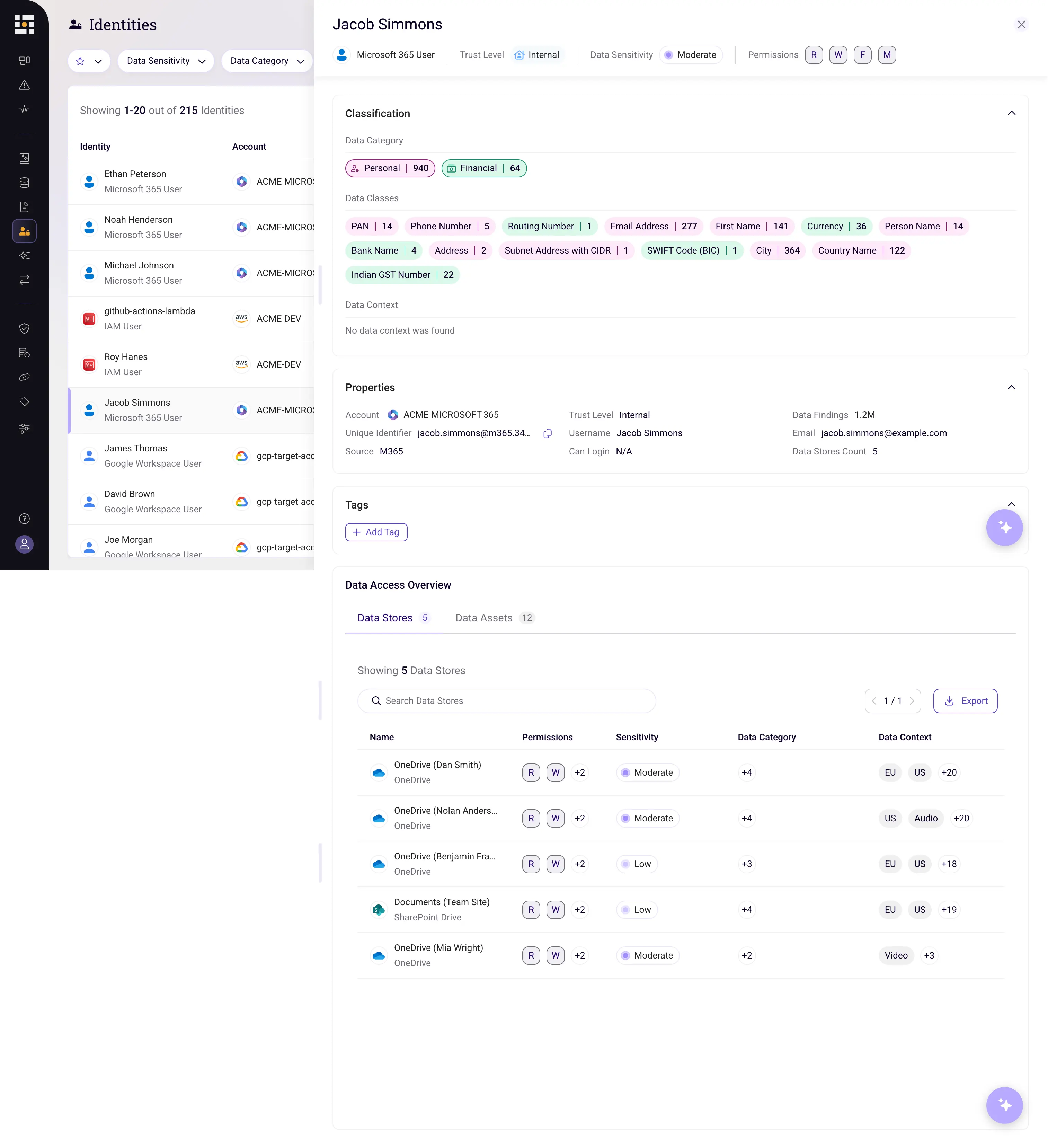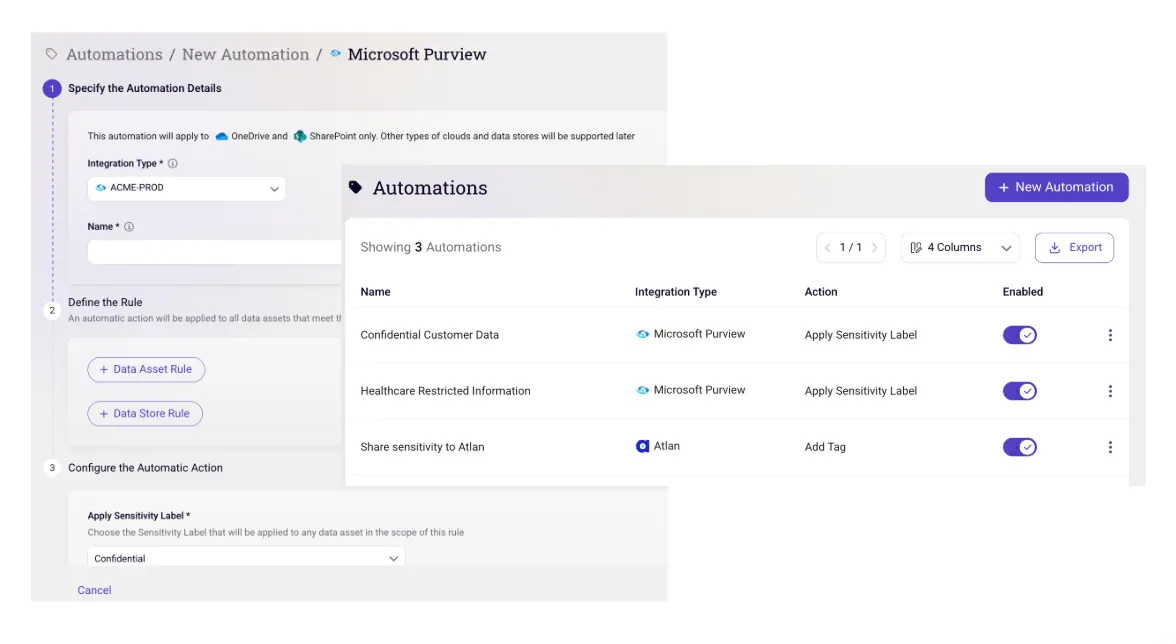Data Loss Prevention for Google Workspace
We know that Google Workspace (formerly known as G Suite) and its assortment of services, including Gmail, Drive, Calendar, Meet, Docs, Sheets, Slides, Chat, and Vids, is a powerhouse for collaboration.
But the big question is: Do you know where your Google Workspace data is—and if it’s secure and who has access to it?
While Google Workspace has become an indispensable pillar in cloud operations and collaboration, its widespread adoption introduces significant security risks that businesses simply can't afford to ignore. To optimize Google Workspace data protection, enterprises must know how Google Workspace protects and classifies data. Knowing the scope, gaps, limitations, and silos of Google Workspace data protection mechanisms can help businesses strategize more effectively to mitigate data risks and ensure more holistic data security coverage across multi-cloud estates.
The Risks of Google Workspace Security
As with any dynamic cloud platform, Google Workspace is susceptible to data security risks, the most dangerous of which can do more than just undercut its benefits. Primarily, businesses should be concerned about the exposure of sensitive data nested within large volumes of unstructured data. For instance, if an employee shares a Google Drive folder or document containing sensitive data but with suboptimal access controls, it could snowball into a large-scale data security disaster.
Without comprehensive visibility into sensitive data exposures across Google Workspace applications, businesses risk serious security threats. Besides sensitive data exposure, these include exploitable vulnerabilities, external attacks, human error, and shadow data. Complex shared responsibility models and unmet compliance policies also loom large, threatening the security of your data.
To tackle these risks, businesses must prioritize and optimize data security across Google Workspace products while acknowledging that Google is rarely the sole platform an enterprise uses.
How Does Google Store Your Data?
To understand how to protect sensitive data in Google Workspace, it's essential to first examine how Google stores and manages this data. Why? Because the intricacies of data storage architectures and practices have significant implications for your security posture.
Here are three-steps to help you understand and optimize your data storage in Google Workspace:
1. Know Where and How Google Stores Your Data
- Google stores your files in customized servers in secure data centers.
- Your data is automatically distributed across multiple regions, guaranteeing redundancy and availability.
2. Control Data Retention
- Google retains your Workspace data until you or an admin deletes it.
- Use Google Vault to manage retention policies and set custom retention rules for emails and files.
- Regularly review and clean up unnecessary stored data to reduce security risks.
3. Secure Your Stored Data
- Enable encryption for sensitive files in Google Drive.
- Restrict who can view, edit, and share stored documents by implementing access controls.
- Monitor data access logs to detect unauthorized access.
How Does Google Workspace Classify Your Data?
Google’s built-in classification tools are an acceptable starting point. However, they fall short of securing and classifying all unstructured data across complex cloud environments. This is because today's cloud attack surface expands across multiple providers, making security more complex than ever before. Consequently, Google's myopic classification often snowballs into bigger security problems, as data moves. Because of this evolving attack surface across multi-cloud environments, risk-ridden shadow data and unstructured data fester in Google Workspace apps.
The Issue of Unstructured Data
It’s important to remember that most enterprise data is unstructured. Unstructured data refers to data that isn’t stored in standardized or easily manageable formats. In Google Workspace, this could be data in a Gmail draft, multimedia files in Google Drive, or other informal exchanges of sensitive information between Workspace apps.
For years, unstructured data has been a nightmare for businesses to map, manage, and secure. Unstructured document stores and employee GDrives are hot zones for data risks. Native Google Drive data classification capabilities can be a useful source of metadata to support a more comprehensive external data classification solution. A cloud-native DSP solution can map, classify, and organize sensitive data, including PHI, PCI, and business secrets, across both Google Workspace and cloud platforms that Google's built-in capabilities do not cover, like AWS and S3.
How Does Google Workspace Protect Your Data?
Like its built-in classification mechanisms, Google's baseline security features, such as encryption and access controls, are good for simple use cases but aren't capable enough to fully protect complex environments.
For both the classification and security of unstructured data, Google’s native tools may not suffice. A robust data loss prevention (DLP) solution should ideally do the trick for unstructured data. However, Google Workspace DLP alone and other protection measures (formerly referred to as G Suite data protection) are unlikely to provide holistic data security, especially in dynamic cloud environments.
Google Native Tool Challenges
Google’s basic protection measures don't tackle the full spectrum of critical Google Workspace data risks because they can't permeate unstructured documents, where sensitive data may reside in various protected states.
For example, an employee's personal Google Drive can potentially house exposed and exploitable sensitive data that can slip through Google's built-in security mechanisms. It’s also important to remember that Google Workspace data loss prevention capabilities do nothing to protect critical enterprise data hosted in other cloud platforms.
Ultimately, while Google provides some security controls, they alone don’t offer the level of protection that today’s complex cloud environments demand. To close these gaps, businesses must look to complement Google’s built-in capabilities and invest in robust data security solutions.
Only a highly integrable data security tool with advanced AI and ML capabilities can protect unstructured data across Google Workspace’s diverse suite of apps, and further, across the entire enterprise data estate. This has become mandatory since multi-cloud architectures are the norm today.
A Robust Data Security Platform: The Key to Holistic Google Workspace Data Protection
The speed, complexity, and rapid evolution of multi-cloud and hybrid cloud environments demand more advanced data security capabilities than Google Workspace’s native storage, classification, and protection features provide.
It is becoming increasingly difficult to mitigate the risks associated with sensitive data.
To successfully remediate these risks, businesses urgently need robust data security posture management (DSPM) and data detection and response (DDR) solutions - preferably all in one platform. There's simply no other way to guarantee comprehensive data protection across Google Workspace. Furthermore, as mentioned earlier, most businesses don't exclusively use Google platforms. They often mix and match services from cloud providers like Google, Azure, and AWS.
In other words, besides limited data classification and protection, Google's built-in capabilities won't be able to extend into other branches of an enterprise's multi-cloud architecture. And having siloed data security tools for each of these cloud platforms increases costs and further complicates administration that can lead to critical coverage gaps. That's why the optimal solution is a holistic platform that can fill the gaps in Google's existing capabilities to provide unified data classification, security, and coverage across all other cloud platforms.
Sentra: The Ultimate Cloud-Agnostic Data Protection and Classification Solution
To truly secure sensitive data across Google Workspace and beyond, enterprises need a cloud-native data security platform. That’s where Sentra comes in. It hands you enterprise-scale data protection by seamlessly integrating powerful capabilities like data discovery and classification, data security posture management (DSPM), data access governance (DAG), and data detection and response (DDR) into an all-in-one, easy-to-use platform.
By combining rule-based and large language model (LLM)-based classification, Sentra ensures accurate and scalable data security across Workspace apps like Google Drive—as well as data contained in apps from other cloud providers. This is crucial for any enterprise that hosts its data across disparate cloud platforms, not just Workspace. To classify unstructured data across these platforms, Sentra leverages supervised AI training models like BERT. It also uses zero-shot classification techniques to zero in on and accurately classify unstructured data.
Sentra is particularly useful for anyone asking business-, industry-, or geography-specific data security questions such as “Does Google Workspace have HIPAA compliance frameworks?” and “Is my organization's use of Google Workspace GDPR-compliant?” The short answer to these questions: Integrate Sentra with your Google Workspace apps and you will see.
Boost Your Google Workspace Data Protection with Sentra
By integrating Sentra with Google Workspace, companies can leverage AI-driven insights to distinguish employee data from customer data, ensuring a clearer understanding of their information landscape. Sentra also identifies customer-specific data types, such as personally identifiable information (PII), protected health information (PHI), product IDs, private codes, and localization requirements. Additionally, it detects toxic data combinations that may pose security risks.
Beyond insights, Sentra provides robust data protection through comprehensive inventorying and classification of unstructured data. It helps organizations right-size permissions, expose shadow data, and implement real-time detection of sensitive data exposure, security breaches, and suspicious activity, ensuring a proactive approach to data security.
No matter where your unstructured data resides, whether in Google Drive or any other cloud service, Sentra ensures it is accurately identified, classified, and protected with over 95% precision.
If you’re ready to take control of your data security, book a demo to discover how Sentra’s AI-driven protection secures your most valuable information across Google Workspace and beyond.
<blogcta-big>










.webp)

.webp)

.webp)
